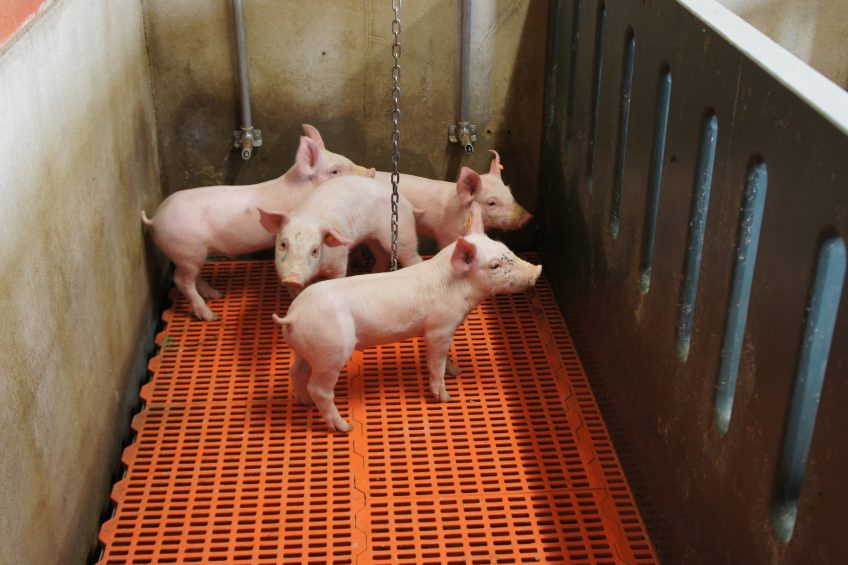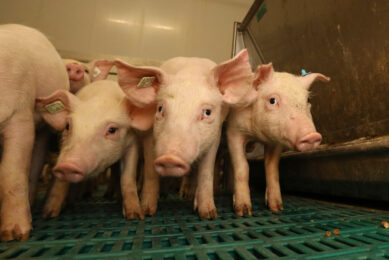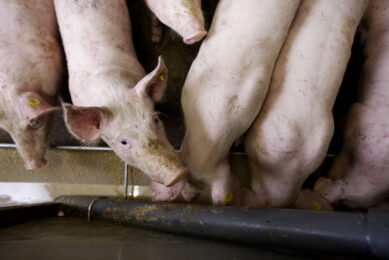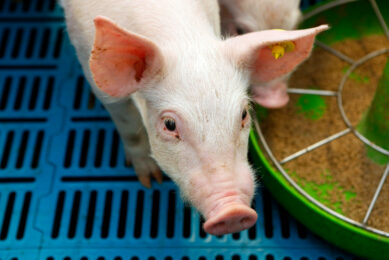Do probiotics clean pig nursery units better?

About correct cleaning and disinfecting of pig houses, many different opinions exist. Belgian researchers thought it was time to bring 2 to the test: does probiotic cleaning have a strong effect and does it make a difference to have a longer downtime between production rounds?
In recent years, various studies have reported that bacteria like Salmonella, methicillin-resistant Staphylococcus aureus (MRSA) and E. coli can develop a resistance against certain disinfection strategies. As a result, ongoing research is being carried out for potential alternatives to conventional cleaning and disinfection methods. Often, probiotic cleaning is suggested as an alternative, the principle being based on the idea that good bacteria would take the place of unwanted bugs like Salmonella, pathogenic E. coli, Enterococcus and MRSA and thus interfere in the communication between bacteria. Nevertheless, little scientific information is available describing the usage and the efficacy of these probiotic solutions in the livestock business.
Probiotic versus conventional strategies
A Belgian PhD study, published in late August 2016, compared a commercial probiotic cleaning protocol to a conventional cleaning and disinfection protocol. The study was done at pig nursery units at the Flemish Institute for Agricultural, Fisheries and Food Research (ILVO) in Melle, Belgium, with the co-operation of Ghent University’s Faculty of Veterinary Medicine.
The trial was carried out with 816 piglets in three successive rounds in six nursery compartments, each containing eight pens per compartment and six piglets per pen.
The piglets were placed into the nursery units immediately after weaning at four weeks of age and stayed in their pens for six weeks. Three compartments were a control group in which conventional cleaning and disinfection was applied when no animals were in there. The other three compartments were part of a probiotic treatment group.
The tested protocols
The conventional protocol consisted of the following steps during 2 weeks prior to the animals’ arrival:
- Cleaning with cold water;
- Soaking with sodium hydroxide and cold water for 30 minutes;
- Flushing with cold water under high pressure;
- Disinfecting with glutaraldehyde and quaternary ammonium compounds on the same day.
The probiotic protocol, without disinfection contained the following steps:
- Cleaning with cold water;
- Soaking with a foam cleaner enriched with bacterial spores of Bacillus and water at 40°C for 10 minutes;
- Flushing with water at 40°C under high pressure;
- Spraying of a probiotic stabilisation product with Bacillus spores in the compartments with and without piglets present, 2 to 3 times per week.
Hygiene control
To get a good idea of the infection pressure, environmental swab samples were collected at four moments of any production round:
- Immediately after the departure of piglets and before cleaning;
- 24 Hours after cleaning (probiotic group) or 24 hours after cleaning and disinfection(control group);
- After 1 week in the production round with animals present; and
- After 5 weeks in the production round.
These samples were analysed for the presence of aerobic Bacillus spores, Enterococcus species, faecal coliforms, E. coli and MRSA. The counting of aerobic Bacillus spores was done mainly to verify whether the probiotic cleaning protocol had been applied correctly. E. coli, faecal coliforms and Enterococcus bacteria were monitored as indicators for hygiene or faecal infection within each compartment.
Growth performance in the weaners
To be able to observe growth performance, the piglets were weighed individually at weaning at 4 weeks of age; at 6 weeks of age and at 9 weeks of age. At those moments, also the feed intake per pen was measured, after which a feed conversion rate could be calculated per pen. Diarrhoea per pen was established using a weekly faeces scoring system. Also clinical signs of diseases as well as antibiotics usage were registered.
Disinfection is crucial
The results showed that significantly higher amounts of Bacillus spores were found in all locations within the probiotic-treated compartments in comparison to the compartments receiving a conventional cleaning and disinfection method. This is an indication that the probiotic protocol was applied correctly.
In general, significantly more enterococci were found in the ‘probiotic’ compartments, compared to ‘conventional’ compartments. In addition, no reduction was observed after the cleaning step in the probiotic compartments, something that was the case in the conventional compartments. In addition, at the end of each production round (after week 5), more enterococci were found in the probiotic compartments despite the additional spraying of the probiotic stabilisation product.
After the cleaning step, also a higher number of samples with faecal coliforms and E. coli were found in the probiotic compartments, when compared to the disinfected conventional compartments. Just as with the enterococci, the number of faecal coliforms did not come down as a result of probiotic cleaning of the compartments. During the production round, with piglets being present, no difference in numbers of faecal coliforms and E. coli was observed between the two compartment types.
Analyses of MRSA confirmed these results and showed that probiotic cleaning and spraying did not have a positive influence on preventing MRSA. On the contrary, after probiotic cleaning even more positive MRSA samples were found when compared to the conventional strategy.
The probiotic cleaning protocol did not affect weaner performance, like feed intake, average daily gain and feed conversion, nor did it have any effect on antibiotics usage. There was no difference in faecal scores between piglets participating in both protocols.
No lower infection pressure
In short, the trials showed that the probiotic protocol in this trial did not lead to a lower infection pressure compared to traditional cleaning and disinfection.
* This article is an approved summary of pieces that appeared in the Belgian trade magazine ‘Varkensbedrijf’. The research was done by Kaat Luyckx, Jeroen Dewulf, Sam Millet, Sarah De Smet, Marc Heyndrickx and Koen De Reu. As lead author, Kaat Luyckx was associated with the Flemish Institute for Agriculture, Fisheries and Food Research (ILVO).
How about a longer downtime?
The research team at ILVO also dived into another potential strategy to enhance biosecurity protocols. Some claim that after cleaning and disinfection, a longer waiting time would further reduce the presence of pathogens present. In a similar trial set-up as described in the probiotic trials, the research group investigated the effect of a downtime of 1, 4, 7 or 10 days after cleaning and disinfection. Again, having taken environmental swabs, the group of researchers concluded that the extending of downtime to 10 days ‘does not yield any additional decrease in the bacterial burden if no additional biosecurity measures are being taken’. In certain cases, they continue, a longer downtime might even be more disadvantageous as rodents or certain insects can bring in pathogens to re-infect the environment. And of course not using the rooms has a financial component for farmers too. Last but not least, the researchers found that in particular the drinking nipples as well as the slatted floors scored high in enterococci.











